san andreas fault
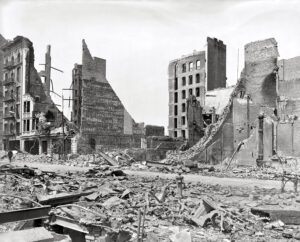 On April 18, 1906, many of the people in the San Francisco, California area were sound asleep in their beds. It was, after all, 5:13am. Suddenly, the people were jolted awake by an earthquake, which was estimated to be close to 8.0 on the Richter scale. When the quake struck San Francisco, California, it toppled numerous buildings. The cause of the quake was a slip of the San Andreas Fault over a segment about 275 miles long. The resulting shock waves could be felt from southern Oregon down to Los Angeles.
On April 18, 1906, many of the people in the San Francisco, California area were sound asleep in their beds. It was, after all, 5:13am. Suddenly, the people were jolted awake by an earthquake, which was estimated to be close to 8.0 on the Richter scale. When the quake struck San Francisco, California, it toppled numerous buildings. The cause of the quake was a slip of the San Andreas Fault over a segment about 275 miles long. The resulting shock waves could be felt from southern Oregon down to Los Angeles.
At that time, San Francisco’s had a variety of brick buildings and wooden Victorian structures that were not really earthquake reinforced. Nobody knew about making buildings strong enough to resist destruction from an earthquake. It was one of the things we would learn from the results of a disaster. It seems that with each disaster, we learn how to prevent the loss of so many buildings and lives. The old buildings were devastated. Along with the collapsed buildings, came devastating fires, and because many of the water mains had broken, firefighters were prevented from stopping 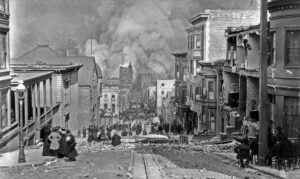 the fires. Firestorms soon developed citywide. US Army troops from Fort Mason reported to the Hall of Justice around 7am, and San Francisco Mayor E.E. Schmitz set a dusk-to-dawn curfew and authorized soldiers to shoot to kill anyone found looting. Disasters like these always seem to bring out the worst in people, even those who might not have done such things under normal circumstances.
the fires. Firestorms soon developed citywide. US Army troops from Fort Mason reported to the Hall of Justice around 7am, and San Francisco Mayor E.E. Schmitz set a dusk-to-dawn curfew and authorized soldiers to shoot to kill anyone found looting. Disasters like these always seem to bring out the worst in people, even those who might not have done such things under normal circumstances.
As significant aftershocks continued, firefighters and US troops fought desperately to control the ongoing fires. Sadly, that sometimes meant dynamiting whole city blocks to create firewalls. Many people were trapped where they were, because the fires prevented their escape, even though they were not stuck in a collapsed building. Finally, on April 20th, several thousands of refugees were evacuated from the foot of Van Ness Avenue. The army would eventually house 20,000 refugees in more than 20 military-style tent camps across the city. The people had no idea how long they might have to be there.
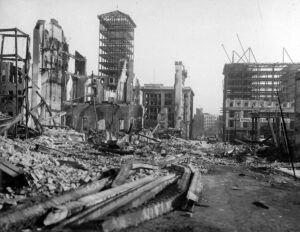
Most of the fires were extinguished by April 23rd, and the authorities started the task of rebuilding the devastated city. In all, approximately 3,000 people lost their lives as a result of the Great San Francisco Earthquake and the devastating fires it inflicted upon the city. Almost 30,000 buildings were destroyed, including most of the city’s homes and nearly all the central business district. The rebuilding would take a long time, and the new structures were reinforced to be able to better withstand the shaking of the San Andreas fault. This quake may not have been the “Big One” that is predicted, but at an estimated 7.9 or 8.0, it was right up there.
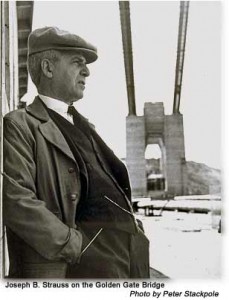 Some challenges are tougher than others, and the challenge to connect San Francisco with Marin County, California rates right up there among the most difficult…at least in 1937. I’m sure there have been bigger challenges since then and even before then, but I think that building what was the longest suspension bridge in the world in 1937 had to be really difficult. The bridge, which was built between January 1933 and May 1937, was to be 4,200 feet long. Its location was probably the biggest challenge the builders faced. The bridge is very close to the San Andreas Fault, which runs north and south directly through the San Francisco area. The bridge had to be built in such a way as to ensure its stability in the event of an earthquake. While earthquakes can happen anywhere in the world, it is such a strange idea to me to build something that depends on solid ground, on a known fault. Nevertheless, the bridge still stands today, and there have been many earthquakes in that area.
Some challenges are tougher than others, and the challenge to connect San Francisco with Marin County, California rates right up there among the most difficult…at least in 1937. I’m sure there have been bigger challenges since then and even before then, but I think that building what was the longest suspension bridge in the world in 1937 had to be really difficult. The bridge, which was built between January 1933 and May 1937, was to be 4,200 feet long. Its location was probably the biggest challenge the builders faced. The bridge is very close to the San Andreas Fault, which runs north and south directly through the San Francisco area. The bridge had to be built in such a way as to ensure its stability in the event of an earthquake. While earthquakes can happen anywhere in the world, it is such a strange idea to me to build something that depends on solid ground, on a known fault. Nevertheless, the bridge still stands today, and there have been many earthquakes in that area.
The second challenge the builders faced was the tumultuous waters the bridge had to span. The dangers that presented for the underwater construction were grave. The construction teams started their work on the peninsulas, building out over the wind-whipped waters of the San Francisco Bay. With labor and 70,000 tons of steel, they built arms that reached out to each other over the straits, getting closer by the day. Given the strait’s precarious mixture of violent winds, swirling currents, and thick fogs, many thought such a bridge couldn’t be built. Nevertheless, the builders have prevailed against the challenges they faced, because the bridge was completed successfully. In all, eleven men would lose their lives during construction, ten of them on February 17, 1937 when a section of scaffold carrying twelve men fell through the safety net.
I think the biggest challenge, that did not involve the elements, was a city who was skeptical and many people who were simply against a bridge across the San Francisco Bay. Nevertheless, Joseph Strauss, the engineer fought for 16 years to convince the people that the bridge was an amazing idea. He was a very proud man when he, on opening day, triumphantly exclaimed, “The bridge which could not and should not be built, which the War Department would not permit, which the rocky foundation of the pier base would not support, which would have no traffic to justify it, which would ruin the beauty of the Golden Gate, which could not be completed within my costs estimate of $27,165,000, stands before you in all its majestic splendor, in complete 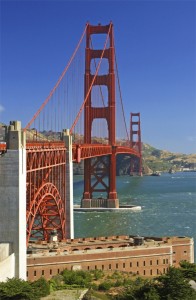 refutation of every attack made upon it.”
refutation of every attack made upon it.”
And so it was that the seemingly impossible was accomplished. The bridge was set to open on May 27, 1937, and by 6:00am, 18,000 people were lined up on both the San Francisco and the Marin county sides. In all, about 200,000 people showed up that day. At the appointed hour, a foghorn blew, and the toll gates opened. The earliest arrivals would have the distinction of being among the first to cross. Many offices, schools, and stores closed to attend the great event. The day was designated Pedestrian Day. The next day, he bridge opened to vehicle traffic. President Franklin Delano Roosevelt proclaimed the bridge open to the world. By the end of that day, 32,000 vehicles had paid the tolls and crossed the historic bridge. In the 70 plus years it has been open, it is estimated that nearly 2 billion vehicles have crossed the bridge. The Golden Gate Bridge and the views it holds are beautiful, and I am happy to have been one of those people to have crossed it.
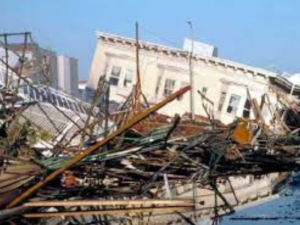 As the 25th anniversary of the Loma Prieta earthquake arrives, I am reminded of the time spent watching the footage of the aftermath. At that time, I had never been to California, and so I didn’t quite understand what I was seeing…but my parents knew. They had been there several times. They kept saying that a lot of people were probably dead on the Oakland Bay Bridge. As I looked at the pictures, and heard the reporter mistakenly describe the bridge, as simply collapsed, so I just didn’t get it. My parents kept saying, “That is a double road…don’t they understand that?” I guess they didn’t…and I didn’t either. They finally told me that it was a double deck bridge. Then I got it…in every sickening detail, I got it. People were trapped under tons of metal and concrete. Maybe their cars could have saved them, but it was doubtful. That was just too much weight. In the end, only one person was killed on the Oakland Bay bridge, because it was closed for retrofitting. The people on The Nimitz Expressway…also a double deck bridge, at the Cypress Street Viaduct, were not so lucky. That bridge also collapsed and when it did, it killed 42 of the total of 67 people killed in the Earthquake.
As the 25th anniversary of the Loma Prieta earthquake arrives, I am reminded of the time spent watching the footage of the aftermath. At that time, I had never been to California, and so I didn’t quite understand what I was seeing…but my parents knew. They had been there several times. They kept saying that a lot of people were probably dead on the Oakland Bay Bridge. As I looked at the pictures, and heard the reporter mistakenly describe the bridge, as simply collapsed, so I just didn’t get it. My parents kept saying, “That is a double road…don’t they understand that?” I guess they didn’t…and I didn’t either. They finally told me that it was a double deck bridge. Then I got it…in every sickening detail, I got it. People were trapped under tons of metal and concrete. Maybe their cars could have saved them, but it was doubtful. That was just too much weight. In the end, only one person was killed on the Oakland Bay bridge, because it was closed for retrofitting. The people on The Nimitz Expressway…also a double deck bridge, at the Cypress Street Viaduct, were not so lucky. That bridge also collapsed and when it did, it killed 42 of the total of 67 people killed in the Earthquake.
The day was October 17, 1989, the first game of the World Series was being played right there in San 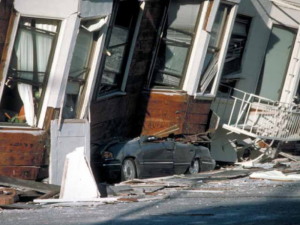 Francisco at Candlestick Park between the two local teams…The Oakland Athletics and the San Francisco Giants. The people in the area were very excited and baseball was the only thing on their minds. The game was to start at 5:30pm, but that was not to be. The earthquake rated a magnitude 7.1 struck at 5:04pm. Game day would have to wait. Today, it was all hands on deck. And the first question on everyone’s mind was, “Is my family safe?” In that moment, all thought of baseball stopped, and everyone’s mind was on finding the victims…and, hopefully finding them alive.
Francisco at Candlestick Park between the two local teams…The Oakland Athletics and the San Francisco Giants. The people in the area were very excited and baseball was the only thing on their minds. The game was to start at 5:30pm, but that was not to be. The earthquake rated a magnitude 7.1 struck at 5:04pm. Game day would have to wait. Today, it was all hands on deck. And the first question on everyone’s mind was, “Is my family safe?” In that moment, all thought of baseball stopped, and everyone’s mind was on finding the victims…and, hopefully finding them alive.
I can’t say that I knew anyone who lived through the earthquake, nor anyone who died in it, but rather what I felt was how it impacted my parents at that time. I also felt that same impact on me when I visited San Francisco a few years later. I don’t think you can know an area where people were killed in an earthquake, or even visit that place and not feel something…not if you knew or remember the disaster that happened in that place. San Francisco is a beautiful place, with so much to see, but it is also a sad place where, over the years, the San Andreas fault has exploded over and 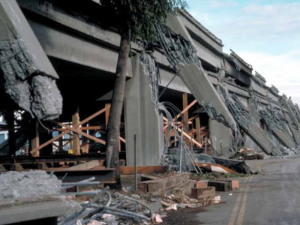 over again, leaving in its wake, the bodies of its victims…and the shattered lives of their families. I suppose there are people who can go there, and give no thought to that historical fact, but I am not one of those people. I think there are places when the memories of tragedies in the past lingers in an almost physical way. The ground becomes almost hallowed, deserving of respect for those who died there. Lives with so much promise, people with so much to live for, were wiped out in just 15 seconds…the 15 seconds that the earthquake was happening. That was all it took…just 15 seconds, and they were gone. That was 25 years ago today, and when I think of all the contributions those people could have made to the world, it makes me very sad indeed.
over again, leaving in its wake, the bodies of its victims…and the shattered lives of their families. I suppose there are people who can go there, and give no thought to that historical fact, but I am not one of those people. I think there are places when the memories of tragedies in the past lingers in an almost physical way. The ground becomes almost hallowed, deserving of respect for those who died there. Lives with so much promise, people with so much to live for, were wiped out in just 15 seconds…the 15 seconds that the earthquake was happening. That was all it took…just 15 seconds, and they were gone. That was 25 years ago today, and when I think of all the contributions those people could have made to the world, it makes me very sad indeed.

